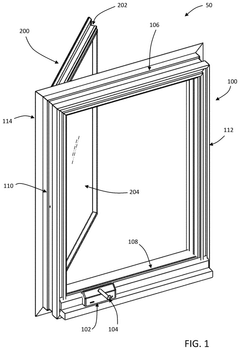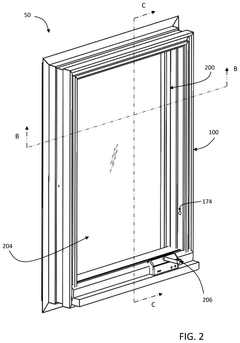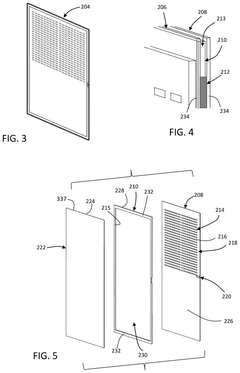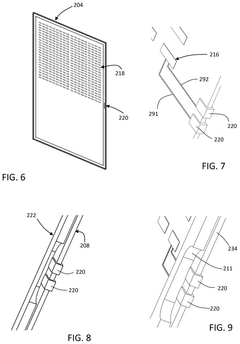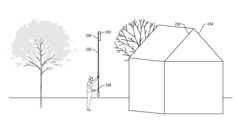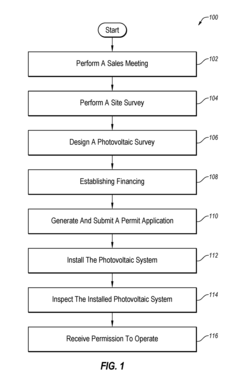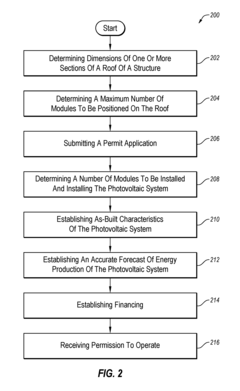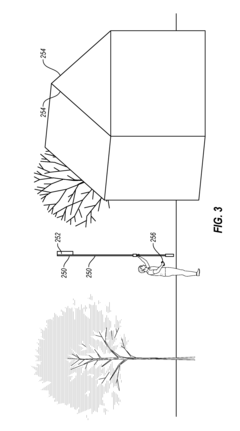Regulatory And Building Code Considerations For Solar Window Installation
AUG 29, 20259 MIN READ
Generate Your Research Report Instantly with AI Agent
Patsnap Eureka helps you evaluate technical feasibility & market potential.
Solar Window Technology Background and Objectives
Solar window technology represents a significant advancement in building-integrated photovoltaics (BIPV), combining traditional window functionality with renewable energy generation capabilities. The evolution of this technology began in the early 2000s with rudimentary semi-transparent solar cells and has since progressed to more sophisticated solutions that maintain aesthetic appeal while generating electricity. The trajectory of development has been characterized by continuous improvements in transparency, efficiency, and integration methods, with recent breakthroughs in transparent luminescent solar concentrators (TLSC) and perovskite-based technologies.
The regulatory landscape for solar windows has evolved alongside technological advancements, with building codes and standards gradually adapting to accommodate these innovative solutions. Initially, solar windows faced significant regulatory barriers due to their hybrid nature, falling between traditional construction materials and energy generation systems. This created challenges in certification, installation approval, and compliance with existing building codes.
Current technical objectives in the field focus on several key areas: increasing energy conversion efficiency while maintaining optimal visible light transmission, developing standardized installation protocols that comply with diverse regional building codes, and creating universal regulatory frameworks that specifically address solar window technology. Additionally, there is a push toward developing solutions that can be retrofitted into existing buildings without requiring extensive structural modifications or special permits.
The intersection of energy regulations and building safety codes presents unique challenges for solar window implementation. Energy performance standards often demand higher efficiency, while building codes prioritize structural integrity, fire safety, and weather resistance. Harmonizing these requirements is essential for widespread adoption and has become a central focus for industry stakeholders and regulatory bodies.
Looking forward, the technical goals include achieving regulatory recognition of solar windows as both building envelope components and energy-generating systems, developing internationally recognized testing and certification standards, and establishing clear pathways for code compliance across different jurisdictions. There is also significant emphasis on creating installation guidelines that address the specific electrical and structural considerations unique to solar windows, which differ substantially from both conventional windows and traditional solar panel installations.
The ultimate objective remains to position solar windows as a mainstream building material that can contribute significantly to net-zero energy building goals while navigating the complex regulatory environment that governs both construction and energy generation systems.
The regulatory landscape for solar windows has evolved alongside technological advancements, with building codes and standards gradually adapting to accommodate these innovative solutions. Initially, solar windows faced significant regulatory barriers due to their hybrid nature, falling between traditional construction materials and energy generation systems. This created challenges in certification, installation approval, and compliance with existing building codes.
Current technical objectives in the field focus on several key areas: increasing energy conversion efficiency while maintaining optimal visible light transmission, developing standardized installation protocols that comply with diverse regional building codes, and creating universal regulatory frameworks that specifically address solar window technology. Additionally, there is a push toward developing solutions that can be retrofitted into existing buildings without requiring extensive structural modifications or special permits.
The intersection of energy regulations and building safety codes presents unique challenges for solar window implementation. Energy performance standards often demand higher efficiency, while building codes prioritize structural integrity, fire safety, and weather resistance. Harmonizing these requirements is essential for widespread adoption and has become a central focus for industry stakeholders and regulatory bodies.
Looking forward, the technical goals include achieving regulatory recognition of solar windows as both building envelope components and energy-generating systems, developing internationally recognized testing and certification standards, and establishing clear pathways for code compliance across different jurisdictions. There is also significant emphasis on creating installation guidelines that address the specific electrical and structural considerations unique to solar windows, which differ substantially from both conventional windows and traditional solar panel installations.
The ultimate objective remains to position solar windows as a mainstream building material that can contribute significantly to net-zero energy building goals while navigating the complex regulatory environment that governs both construction and energy generation systems.
Market Analysis for Solar Window Solutions
The solar window solutions market is experiencing significant growth as building owners and developers increasingly seek sustainable energy alternatives. Current market analysis indicates that the global solar window market was valued at approximately $4.2 billion in 2022, with projections suggesting a compound annual growth rate of 16.7% through 2030. This growth is primarily driven by escalating energy costs, heightened environmental awareness, and governmental incentives for renewable energy adoption.
Demand segmentation reveals distinct market sectors with varying adoption rates. Commercial buildings represent the largest market segment, accounting for roughly 58% of total installations, as corporations pursue green building certifications and sustainability goals. Residential applications follow at 27%, with institutional buildings comprising the remaining 15%. Geographically, Europe leads adoption with 39% market share, followed by North America at 32%, Asia-Pacific at 21%, and other regions at 8%.
Consumer preference analysis indicates that building owners prioritize aesthetics, energy efficiency, and return on investment when considering solar window solutions. Transparency levels, color options, and seamless integration with existing architecture remain critical decision factors. Market research shows that 73% of commercial property developers consider energy-generating capabilities as "very important" in new construction window specifications.
Price sensitivity varies significantly across market segments. Premium commercial developments demonstrate willingness to pay 30-40% more for high-performance solar windows, while the residential sector shows greater price elasticity, with acceptance thresholds typically capped at 20-25% above conventional window costs.
Market penetration faces several barriers including high initial costs, limited awareness of technological advancements, and concerns about long-term reliability. Installation complexity and regulatory compliance requirements further impede widespread adoption, particularly in retrofit applications where building code compliance can present significant challenges.
Distribution channels are evolving rapidly, with specialized solar solution providers gaining market share from traditional window manufacturers. Strategic partnerships between technology developers and established building material suppliers are reshaping the competitive landscape. Direct-to-consumer models are emerging in the residential sector, while commercial applications remain predominantly project-based through architectural specification.
Future market growth will likely be influenced by technological innovations that improve efficiency and reduce costs, evolving building codes that increasingly mandate energy-generating components, and expanded government incentive programs supporting renewable energy integration in buildings.
Demand segmentation reveals distinct market sectors with varying adoption rates. Commercial buildings represent the largest market segment, accounting for roughly 58% of total installations, as corporations pursue green building certifications and sustainability goals. Residential applications follow at 27%, with institutional buildings comprising the remaining 15%. Geographically, Europe leads adoption with 39% market share, followed by North America at 32%, Asia-Pacific at 21%, and other regions at 8%.
Consumer preference analysis indicates that building owners prioritize aesthetics, energy efficiency, and return on investment when considering solar window solutions. Transparency levels, color options, and seamless integration with existing architecture remain critical decision factors. Market research shows that 73% of commercial property developers consider energy-generating capabilities as "very important" in new construction window specifications.
Price sensitivity varies significantly across market segments. Premium commercial developments demonstrate willingness to pay 30-40% more for high-performance solar windows, while the residential sector shows greater price elasticity, with acceptance thresholds typically capped at 20-25% above conventional window costs.
Market penetration faces several barriers including high initial costs, limited awareness of technological advancements, and concerns about long-term reliability. Installation complexity and regulatory compliance requirements further impede widespread adoption, particularly in retrofit applications where building code compliance can present significant challenges.
Distribution channels are evolving rapidly, with specialized solar solution providers gaining market share from traditional window manufacturers. Strategic partnerships between technology developers and established building material suppliers are reshaping the competitive landscape. Direct-to-consumer models are emerging in the residential sector, while commercial applications remain predominantly project-based through architectural specification.
Future market growth will likely be influenced by technological innovations that improve efficiency and reduce costs, evolving building codes that increasingly mandate energy-generating components, and expanded government incentive programs supporting renewable energy integration in buildings.
Regulatory Landscape and Technical Barriers
The regulatory landscape for solar window installations varies significantly across jurisdictions, creating a complex web of requirements that manufacturers, installers, and property owners must navigate. At the federal level in the United States, the Department of Energy (DOE) and Environmental Protection Agency (EPA) establish baseline standards for energy efficiency and environmental impact, while state and local governments implement more specific building codes and zoning regulations. This multi-layered regulatory framework often results in inconsistent requirements across different regions, complicating widespread adoption.
Building codes present particularly challenging barriers for solar window technology integration. Most existing building codes were developed before the emergence of building-integrated photovoltaics (BIPV) like solar windows, resulting in classification ambiguities. These technologies must simultaneously satisfy requirements for both traditional windows (focusing on structural integrity, weather resistance, and thermal performance) and electrical systems (addressing safety, grounding, and interconnection standards).
Fire safety regulations impose additional constraints, as solar windows must demonstrate compliance with flame spread ratings and smoke development indices. The National Electrical Code (NEC) requirements for photovoltaic systems add another layer of complexity, mandating specific wiring methods, disconnection capabilities, and labeling protocols that may be difficult to implement within the confined space of window frames.
Permitting processes represent a significant procedural barrier, often requiring multiple approvals from different departments (building, electrical, zoning) with varying levels of familiarity with solar window technology. The lack of standardized permitting procedures across jurisdictions increases administrative burdens and project timelines, ultimately raising costs for implementation.
Historical preservation regulations create unique challenges in retrofit applications, as many preservation codes strictly limit modifications to building facades in designated historic districts. These restrictions can effectively prevent solar window installations in older urban areas where building stock might otherwise benefit from energy efficiency improvements.
International variations in regulatory approaches further complicate global market development. The European Union has established the Energy Performance of Buildings Directive (EPBD) that encourages building-integrated renewable technologies but implementation varies across member states. Meanwhile, rapidly developing markets like China and India are creating their own regulatory frameworks, often with different technical standards and certification requirements.
Technical certification presents another significant barrier, as solar windows must satisfy multiple testing protocols to demonstrate compliance with both glazing standards (ASTM, AAMA) and photovoltaic performance standards (IEC, UL). The cost and time required for these certifications can be prohibitive for emerging manufacturers, slowing innovation and market entry.
Building codes present particularly challenging barriers for solar window technology integration. Most existing building codes were developed before the emergence of building-integrated photovoltaics (BIPV) like solar windows, resulting in classification ambiguities. These technologies must simultaneously satisfy requirements for both traditional windows (focusing on structural integrity, weather resistance, and thermal performance) and electrical systems (addressing safety, grounding, and interconnection standards).
Fire safety regulations impose additional constraints, as solar windows must demonstrate compliance with flame spread ratings and smoke development indices. The National Electrical Code (NEC) requirements for photovoltaic systems add another layer of complexity, mandating specific wiring methods, disconnection capabilities, and labeling protocols that may be difficult to implement within the confined space of window frames.
Permitting processes represent a significant procedural barrier, often requiring multiple approvals from different departments (building, electrical, zoning) with varying levels of familiarity with solar window technology. The lack of standardized permitting procedures across jurisdictions increases administrative burdens and project timelines, ultimately raising costs for implementation.
Historical preservation regulations create unique challenges in retrofit applications, as many preservation codes strictly limit modifications to building facades in designated historic districts. These restrictions can effectively prevent solar window installations in older urban areas where building stock might otherwise benefit from energy efficiency improvements.
International variations in regulatory approaches further complicate global market development. The European Union has established the Energy Performance of Buildings Directive (EPBD) that encourages building-integrated renewable technologies but implementation varies across member states. Meanwhile, rapidly developing markets like China and India are creating their own regulatory frameworks, often with different technical standards and certification requirements.
Technical certification presents another significant barrier, as solar windows must satisfy multiple testing protocols to demonstrate compliance with both glazing standards (ASTM, AAMA) and photovoltaic performance standards (IEC, UL). The cost and time required for these certifications can be prohibitive for emerging manufacturers, slowing innovation and market entry.
Current Building Integration Solutions
01 Building code compliance for solar windows
Solar windows must comply with various building codes and standards to ensure safety and performance. These regulations cover aspects such as structural integrity, energy efficiency ratings, and installation requirements. Manufacturers need to ensure their solar window products meet local, state, and national building code requirements before installation in residential or commercial buildings.- Building code compliance for solar windows: Solar windows must comply with various building codes and standards to ensure safety and performance. These regulations cover aspects such as structural integrity, energy efficiency ratings, and installation requirements. Manufacturers need to ensure their solar window products meet local, state, and national building codes before installation in residential or commercial buildings. Compliance with these regulations is essential for obtaining necessary permits and approvals.
- Energy efficiency certification requirements: Solar windows must meet specific energy efficiency certification requirements to be marketed and sold as energy-efficient products. These certifications may include ratings from organizations that evaluate the window's ability to generate power while maintaining thermal insulation properties. The certification process involves testing for parameters such as solar heat gain coefficient, U-factor, and power generation capacity. Manufacturers must obtain these certifications to demonstrate compliance with energy efficiency standards.
- Environmental compliance and sustainability reporting: Manufacturers of solar windows must adhere to environmental regulations regarding materials used, manufacturing processes, and end-of-life disposal. This includes compliance with restrictions on hazardous substances, carbon footprint reporting, and sustainability metrics. Companies may need to document their environmental impact through formal sustainability reports and demonstrate adherence to green building standards. These environmental compliance requirements vary by jurisdiction and may affect product marketability.
- Intellectual property and patent compliance: Solar window technology often involves numerous patents and intellectual property considerations that manufacturers must navigate. Companies must ensure they have proper licenses for any patented technologies incorporated into their products or develop non-infringing alternatives. This includes conducting freedom-to-operate analyses and maintaining proper documentation of innovation ownership. Compliance with intellectual property laws is crucial to avoid litigation and ensure legal market entry.
- Market certification and consumer protection regulations: Solar windows are subject to consumer protection regulations that govern advertising claims, performance guarantees, and warranty requirements. Manufacturers must accurately represent the capabilities of their products and provide clear information about expected energy generation. These regulations may require specific labeling, disclosure of performance metrics, and adherence to truth-in-advertising standards. Compliance with these consumer protection measures helps maintain market integrity and consumer confidence in solar window technology.
02 Energy efficiency certification standards
Solar windows require specific energy efficiency certifications to meet regulatory compliance. These standards evaluate factors such as solar heat gain coefficient, U-factor, visible light transmittance, and overall energy performance. Certification programs provide a framework for measuring and verifying the energy efficiency claims of solar window technologies, which is essential for market acceptance and regulatory approval.Expand Specific Solutions03 Environmental impact assessment and compliance
Regulatory frameworks require environmental impact assessments for solar window technologies. These assessments evaluate the lifecycle environmental footprint, including manufacturing processes, materials used, and end-of-life disposal considerations. Compliance with environmental regulations ensures that solar windows deliver genuine sustainability benefits while minimizing negative environmental impacts throughout their lifecycle.Expand Specific Solutions04 Intellectual property and patent compliance
Solar window technologies often involve complex intellectual property considerations. Manufacturers must navigate patent landscapes to ensure their products don't infringe on existing patents while protecting their own innovations. Regulatory compliance in this area includes proper patent filings, licensing agreements, and adherence to intellectual property laws across different jurisdictions where the solar windows will be marketed and sold.Expand Specific Solutions05 Safety standards and certification requirements
Solar windows must meet specific safety standards and certification requirements before market approval. These include electrical safety standards for power-generating components, structural safety for various weather conditions, and hazardous materials restrictions. Certification processes typically involve third-party testing and verification to ensure the solar windows meet all applicable safety regulations and can be safely integrated into building envelopes.Expand Specific Solutions
Key Industry Players and Competitive Analysis
The solar window installation regulatory landscape is evolving as this technology transitions from emerging to growth phase. The market is projected to expand significantly, driven by increasing green building initiatives and energy efficiency requirements. Currently, the technology demonstrates varying maturity levels across applications. Leading players like SolarWindow Technologies and ClearVue Technologies are pioneering transparent photovoltaic solutions, while established companies such as 3M Innovative Properties and Vivint Solar bring manufacturing expertise and installation capabilities. Academic institutions including The University of Sydney and Huazhong University of Science & Technology are advancing research in this field. The regulatory framework remains complex, with building codes and electrical standards still adapting to accommodate this innovative technology that bridges construction and renewable energy sectors.
3M Innovative Properties Co.
Technical Solution: 3M Innovative Properties has developed a comprehensive approach to solar window installation that addresses regulatory and building code considerations through their advanced materials science expertise. Their solution incorporates specialized films and adhesives that can be applied to existing windows or integrated into new construction. The 3M system includes transparent photovoltaic films that generate electricity while maintaining visibility and meeting glazing safety requirements. Their technology addresses thermal performance requirements through selective spectral filtering that reduces heat gain while maximizing light transmission, helping buildings meet energy efficiency codes. 3M has engineered their solar window solutions to comply with fire safety codes through the use of flame-retardant materials and designs that prevent electrical hazards. Their installation systems include weatherproofing components that maintain building envelope integrity and prevent water infiltration, addressing critical waterproofing requirements in building codes. The company provides comprehensive technical documentation packages for their solar window products that include UL certification details, structural performance data, and installation guidelines specifically designed to streamline the permitting and inspection processes across different jurisdictions.
Strengths: 3M's extensive experience with building materials and global regulatory environments allows them to create solutions that address multiple code requirements simultaneously. Their film-based approach enables retrofitting existing buildings without major structural modifications. Weaknesses: The film-based technology may have shorter lifespan than other solar solutions, potentially requiring more frequent replacement and associated permitting processes.
Morgan Solar, Inc.
Technical Solution: Morgan Solar has developed an innovative approach to solar window integration that specifically addresses regulatory and building code challenges through their proprietary Light-Guide Solar Optic (LSO) technology. Their system uses optical concentrators embedded within window structures to direct sunlight to high-efficiency solar cells located at the edges of the window frame. This design maintains window transparency while generating electricity, addressing both aesthetic requirements and energy code provisions. Morgan Solar's technology includes specialized mounting systems designed to distribute loads appropriately across building structures, meeting structural engineering requirements in building codes. Their windows incorporate thermal break technology that helps buildings meet energy efficiency requirements while preventing condensation issues that could violate building moisture management codes. The company has developed comprehensive installation protocols that address electrical code requirements for safe integration with building power systems, including specialized connectors and raceways that meet NEC (National Electrical Code) standards. Their products undergo extensive testing for wind resistance, water penetration, and thermal cycling to ensure compliance with ASTM and AAMA standards referenced in building codes across North America and internationally.
Strengths: The edge-mounted solar cell design maintains excellent transparency while generating significant power, helping meet both daylighting requirements and renewable energy goals. The system's modular design facilitates easier replacement of components, simplifying maintenance compliance issues. Weaknesses: The specialized optical technology requires precise installation, potentially increasing the complexity of meeting installation quality requirements during building inspections.
Critical Patents and Technical Standards Review
Solar window construction and methods
PatentPendingUS20240333202A1
Innovation
- The development of transparent and semi-transparent solar collectors integrated within window scaffoldings or directly within frames, utilizing argon gas for insulation, electrochromatic coatings for tint control, and innovative conductor designs such as flexible bus bars and positional contact interference to ensure reliable energy transfer and easy maintenance.
Solar system installation
PatentInactiveUS20160238388A1
Innovation
- A method that eliminates the need for pre-installation site surveys by using aerial imagery and remote assessments to determine approximate roof dimensions and shading, allowing for the installation of a range of PV modules within specified regions, with detailed energy forecasts established post-installation, reducing the need for precise module placement and permitting complexities.
Building Code Compliance Strategies
Compliance with building codes represents a critical pathway for the successful implementation of solar window installations. Organizations must develop comprehensive strategies that address both national and local regulatory frameworks. The International Building Code (IBC) and International Residential Code (IRC) provide foundational requirements that must be integrated into any compliance approach, particularly regarding structural loading, fire safety, and electrical connections.
A multi-tiered compliance strategy begins with thorough pre-installation assessment. This involves detailed site evaluations to identify building-specific requirements and potential code conflicts. Documentation of existing structural conditions and electrical systems creates a baseline for compliance planning and helps anticipate necessary modifications to meet code requirements.
Engagement with local building departments early in the planning process significantly reduces approval delays. Many jurisdictions offer pre-application consultations where project specifics can be discussed with code officials before formal submission. This proactive approach allows for identification of potential compliance issues and jurisdiction-specific interpretations of building codes that might affect solar window installations.
Technical compliance documentation packages must be meticulously prepared. These should include detailed engineering analyses demonstrating that solar window installations meet structural requirements, particularly regarding wind and snow loads. Electrical diagrams must show compliance with National Electrical Code (NEC) requirements, especially Article 690 which specifically addresses photovoltaic systems.
Third-party certification represents another valuable compliance strategy. Products with UL certification (particularly UL 1703 for photovoltaic modules) and certification from the Solar Rating and Certification Corporation (SRCC) significantly streamline the approval process. These certifications provide code officials with independent verification that products meet established safety and performance standards.
Variance and alternative compliance paths should be explored when standard code provisions create barriers to installation. Many jurisdictions allow for alternative means and methods that achieve the intent of the code without strictly following prescriptive requirements. This approach requires robust technical justification demonstrating equivalent safety and performance.
Post-installation compliance verification ensures long-term code adherence. This includes thorough documentation of the completed installation, coordination of required inspections, and development of maintenance protocols that maintain compliance throughout the system's operational life. Creating a compliance verification checklist specific to the jurisdiction helps ensure all inspection points are addressed.
A multi-tiered compliance strategy begins with thorough pre-installation assessment. This involves detailed site evaluations to identify building-specific requirements and potential code conflicts. Documentation of existing structural conditions and electrical systems creates a baseline for compliance planning and helps anticipate necessary modifications to meet code requirements.
Engagement with local building departments early in the planning process significantly reduces approval delays. Many jurisdictions offer pre-application consultations where project specifics can be discussed with code officials before formal submission. This proactive approach allows for identification of potential compliance issues and jurisdiction-specific interpretations of building codes that might affect solar window installations.
Technical compliance documentation packages must be meticulously prepared. These should include detailed engineering analyses demonstrating that solar window installations meet structural requirements, particularly regarding wind and snow loads. Electrical diagrams must show compliance with National Electrical Code (NEC) requirements, especially Article 690 which specifically addresses photovoltaic systems.
Third-party certification represents another valuable compliance strategy. Products with UL certification (particularly UL 1703 for photovoltaic modules) and certification from the Solar Rating and Certification Corporation (SRCC) significantly streamline the approval process. These certifications provide code officials with independent verification that products meet established safety and performance standards.
Variance and alternative compliance paths should be explored when standard code provisions create barriers to installation. Many jurisdictions allow for alternative means and methods that achieve the intent of the code without strictly following prescriptive requirements. This approach requires robust technical justification demonstrating equivalent safety and performance.
Post-installation compliance verification ensures long-term code adherence. This includes thorough documentation of the completed installation, coordination of required inspections, and development of maintenance protocols that maintain compliance throughout the system's operational life. Creating a compliance verification checklist specific to the jurisdiction helps ensure all inspection points are addressed.
Environmental Impact Assessment
The environmental impact of solar window installations extends far beyond the immediate energy savings they provide. These innovative building components contribute significantly to reducing greenhouse gas emissions by decreasing reliance on fossil fuel-generated electricity. A typical residential solar window installation can prevent approximately 1-2 tons of carbon dioxide emissions annually, depending on the size and efficiency of the system.
Solar windows also offer substantial benefits in terms of resource conservation. Unlike conventional energy production methods, solar windows generate clean electricity without consuming water resources or producing harmful waste products. This aspect becomes increasingly important in regions facing water scarcity challenges, where traditional power generation facilities place additional strain on limited water supplies.
The manufacturing process of solar windows does create an environmental footprint that must be considered in comprehensive assessments. The production of photovoltaic materials involves energy-intensive processes and the use of certain rare earth elements. However, lifecycle analyses indicate that solar windows typically achieve energy payback within 1-3 years, meaning they generate more clean energy during their operational lifetime than was required for their production.
Building-integrated photovoltaics like solar windows also reduce the need for additional land use compared to traditional solar farms. By utilizing existing building surfaces, these technologies minimize habitat disruption and land conversion issues associated with large-scale solar installations. This dual-purpose approach to building materials represents a more efficient use of resources in urban environments.
Local ecosystems may experience positive effects from widespread solar window adoption. The reduction in urban heat island effect can be significant, as solar windows absorb solar radiation that would otherwise contribute to increased ambient temperatures in built environments. Studies suggest that buildings with integrated solar technologies can reduce surrounding air temperatures by 2-4°C during peak summer conditions.
End-of-life considerations remain an important environmental factor. Current solar window technologies have expected lifespans of 20-30 years, after which recycling processes must address the composite materials used in their construction. Emerging recycling technologies are improving recovery rates for valuable materials, though regulatory frameworks for proper disposal and recycling infrastructure continue to develop alongside the technology itself.
Solar windows also offer substantial benefits in terms of resource conservation. Unlike conventional energy production methods, solar windows generate clean electricity without consuming water resources or producing harmful waste products. This aspect becomes increasingly important in regions facing water scarcity challenges, where traditional power generation facilities place additional strain on limited water supplies.
The manufacturing process of solar windows does create an environmental footprint that must be considered in comprehensive assessments. The production of photovoltaic materials involves energy-intensive processes and the use of certain rare earth elements. However, lifecycle analyses indicate that solar windows typically achieve energy payback within 1-3 years, meaning they generate more clean energy during their operational lifetime than was required for their production.
Building-integrated photovoltaics like solar windows also reduce the need for additional land use compared to traditional solar farms. By utilizing existing building surfaces, these technologies minimize habitat disruption and land conversion issues associated with large-scale solar installations. This dual-purpose approach to building materials represents a more efficient use of resources in urban environments.
Local ecosystems may experience positive effects from widespread solar window adoption. The reduction in urban heat island effect can be significant, as solar windows absorb solar radiation that would otherwise contribute to increased ambient temperatures in built environments. Studies suggest that buildings with integrated solar technologies can reduce surrounding air temperatures by 2-4°C during peak summer conditions.
End-of-life considerations remain an important environmental factor. Current solar window technologies have expected lifespans of 20-30 years, after which recycling processes must address the composite materials used in their construction. Emerging recycling technologies are improving recovery rates for valuable materials, though regulatory frameworks for proper disposal and recycling infrastructure continue to develop alongside the technology itself.
Unlock deeper insights with Patsnap Eureka Quick Research — get a full tech report to explore trends and direct your research. Try now!
Generate Your Research Report Instantly with AI Agent
Supercharge your innovation with Patsnap Eureka AI Agent Platform!
